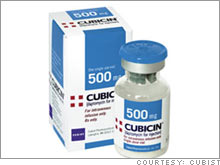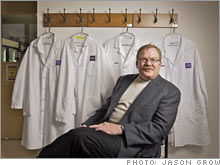Problem no. 8: Drug-resistant infectionsCubist Pharmaceuticals is building a killer arsenal to fight today's ultra-resistant infections.SAN FRANCISCO (Business 2.0 Magazine) -- The background: Bacterial infections that were once easily treated with antibiotics like penicillin have gained frightening resistance during the past few decades - despite the mistaken assurance by the U.S. surgeon general in 1969 that "the war on infectious disease has been won." The war has started all over again, and right now the bugs are winning. In 1974 just 2 percent of the most common form of staph infections found in hospitals were resistant to the common antibiotic methicillin; today more than 60 percent are impervious to it. This year nearly 2 million Americans will get bacterial infections while in a hospital; 90,000 of them will die.
 The solution: The key to battling these new bugs is developing new classes of antibiotics. But they're not coming from Big Pharma: Just 13 antibiotics have reached the market since 1998, after drug companies began scaling back antibiotics in favor of blockbuster drugs for everything from depression to high cholesterol. And of the new antibiotics, only one - Cubicin, from Massachusetts-based biotech Cubist Pharmaceuticals - has been a true winner. Cubicin hit the market in 2003 as a treatment for serious skin infections caused by bacteria that invade during surgery. In 2006 it was approved for bloodstream infections from drug-resistant staph contracted through catheters, surgeries, or IV drug use. The payoff: Cubist, which went public in 1996, has brought in more than $320 million in Cubicin sales so far, making it the most successful new intravenous antibiotic ever. Its third-quarter sales hit $50 million, a 65 percent jump from 2005, and annual revenue is expected to reach $200 million by 2008. But only now is it paying off. "We spent $490 million to get Cubicin into the market," says CEO Mike Bonney. "And in the third quarter, we turned our first profit quarter since the company was founded." Bonney already has two new anti-infective uses for Cubicin in clinical trials (see correction below). Other earlier-stage drugs target lung infection and an increasingly life-threatening form of hospital-acquired diarrhea. Because of its smaller size (409 employees), Bonney says, the company can earn a tidy profit on drugs that bring in $200 million to $300 million a year, although he anticipates a much bigger market with each. The opportunity: Current estimates place the annual cost of treating drug-resistant infections at more than $10 billion. As ultra-resistant strains continue to rise, so will demand - both for treatments and for new ways of preventing the spread of bacteria before it takes root in a person's body. A handful of biotechs, including Basilea, Oscient, and Paratek, are already chasing new classes of antibiotics but have yet to get federal approval for their top prospects. The rules of the game apply as much to startups as to Big Pharma: It takes five to eight years to discover a drug candidate and another five to eight years to get a green light from the FDA. "Cubist scientists anticipated the drug-resistant staph infections we are seeing explode today," Bonney says. "You need to be incredibly prescient in this field and understand what is going to be the problem 10 to 16 years out. And you need patient investors." Correction: An earlier version of this story incorrectly stated that Cubist Pharmaceuticals has two new drugs awaiting FDA approval. As the story now states, Cubist has two new uses for its existing drug, Cubicin, in clincial trials. |
Sponsors
| ||||||||||||

